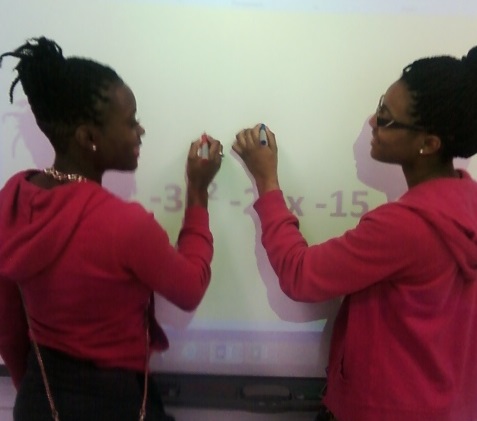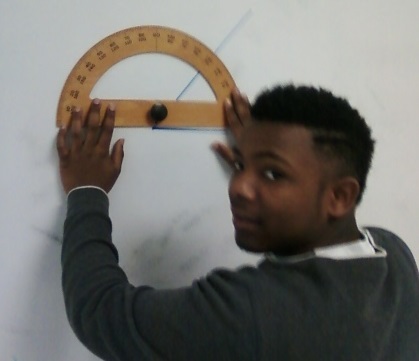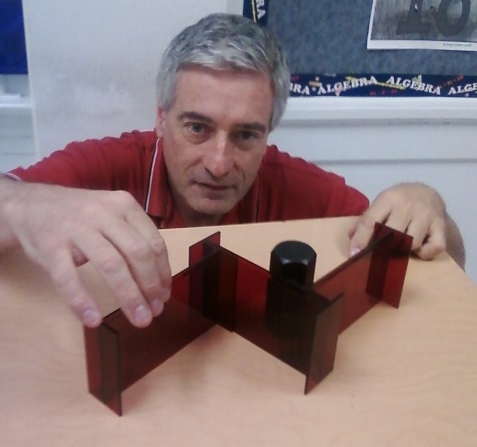Unit One: BASIC TRIGONOMETRIC RATIOS |
|
I can Convert decimal degree measures to degrees, minutes, and seconds and vice versa.
I can Find the number of degrees in a given number of rotations.
I can Identify angles that are coterminal with a given angle. |
|
I can Find the values of trigonometric ratios for acute angles of right triangles.
|
|
I can Find the values of six trigonometric functions using the unit circle.
I can Find the values of six trigonometric functions of an angle in standard position given a point on its terminal side. |
|
I can Use trigonometry to find the measures of the sides of right triangles.
|
|
I can Evaluate inverse trigonometric functions.
I can Solve right triangles.
I can Find missing angle measurements.
|
|
I can Solve triangles by using the Law of Sines if the measures of two angles and a side are given.
I can Find the area of a triangle if the measures of two sides and the included angle or the measures of two angles and a side are given.
|
|
I can Determine whether a triangle has zero, one, or two solutions.
I can Solve triangles using the Law of Sines. |
|
I can Solve triangles by using the Law of Cosines.
I can Find the area of triangles if the measure of the three sides are given.
I can Use a program to solve triangles. |
|
I can memorize the basic trigonometric ratios.
I can solve equations involving trigonometric ratios. |
|
I can solve problems using trigonometric ratios and the angles of elevation and depression.
|
|
I can find the values of inverse trigometric functions.
I can solve equations by using inverse trigometric functions. |
|
Unit two: GRAPHING TRIG RATIOS |
|
I can Change from radian measure to degree measure, and vice versa
I can Find the length of an arc given the measure of the central angle
I can Find the area of a sector. |
|
I can Find linear and angular velocity.
|
|
I can Use the graphs of the sine and cosine functions.
|
|
I can Find the amplitude and period for sine and cosine functions.
I can Write equations of sine and cosine functions given the amplitude and period.
|
|
I can Find the phase shift and the vertical translation for sine and cosine functions.
I can Graph compound functions.
I can Write the equations of sine and cosine functions given the amplitude, period, phase shift, and vertical translation. |
|
I can Model real-world data using sine and cosine functions.
I can Use sinusoidal functions to solve problems. |
|
I can Graph tangent, cotangent, secant, and cosecant functions.
I can Write equations of trigonometric functions. |
|
I can Use a graphing calculator to model beat effects produced by waves of almost equal frequencies.
I can Graph inverse trigonometric functions.
I can Find principal values of inverse trigonometric functions
|
|
I can find values of trigometric functions for acute angles.
I can use trigometric functions to find side lengths and angle measures of right triangles. |
|
I can draw and find angles in standard positions.
I can convert between degrees and radians. |
|
I can find the values for trig functions for general angles.
I can find the values for trig functions by using reference angles. |
|
I can find the area of a triangle using two sides and an included angle.
I can use the law of sines to solve triangles. |
|
I can use the law of cosines to solve triangles.
I can choose methords to solve triangles. |
|
I can find the values of trigometric functions based on the unit circle.
I can use the properties of periodic functions to evaluate trigometric functions. |
|
I can describe and graph the sine, cosine, and tangent functions.
I can describe and graph other trigometric functions. |
|
I can graph horizontial translations of trigometric graphs and find phase shifts.
I can graph vertical translations of trigometric graphs. |
|
I can Find equal, opposite, and parallel vectors.
I can Add and subtract vectors geometrically. |
|
I can Find ordered pairs that represent vectors.
I can Add, subtract, multiply, and find the magnitude of vectors algebraically.
|
|
I can Add and subtract vectors in three-dimensional space.
I can Find the magnitude of vectors in three-dimensional space. |
|
I can Find the inner and cross products of two vectors.
I can Determine whether two vectors are perpendicular.
I can Use a graphing calculator program to obtain the components of the cross product of two vectors in space.
|
|
I can Graph points in polar coordinates.
I can Graph simple polar equations.
I can Determine the distance between two points with polar coordinates.
|
|
I can Graph polar equations.
|
|
I can Solve problems using vectors and right triangle trigonometry.
|
|
I can Write vector and parametric equations of lines.
I can Graph parametric equations.
I can Investigate the use of parametric equations.
|
|
I can Model the motion of a projectile using parametric equations.
I can Solve problems related to the motion of a projectile, its trajectory, and range.
|
|
I can Transform three-dimensional figures using matrix operations to describe the transformation. |
|
I can Convert between polar and rectangular coordinates.
|
|
I can Write the polar form of a linear equation.
I can Graph the polar form of a linear equation.
|
|
I can Add, subtract, multiply, and divide complex numbers in rectangular form.
|
|
I can Graph complex numbers in the complex plane.
I can Convert complex numbers from rectangular to polar form and vice versa.
I can Explore geometric relationships in the complex plane.
|
|
I can Find the product and quotient of complex numbers in polar form.
|
|
I can Find powers and roots of complex numbers in polar form using De Moivre's Theorem.
|
|
Unit Three: TRIGONOMETRIC IDENTITY |
|
I can use trigometric identies to find trigometric values.
I can use trigometric identies to simplify expressions. |
|
I can verify trigometric identies by transforming one side of an equation .
I can verify trigometric identies by transforming each side of an equation . |
|
I can find values of sine and cosine by using sum and difference identies.
I can verify trigometric identies of sine and cosine by using sum and difference identies. |
|
I can find values of sine and cosine by using double angle identies.
I can find values of sine and cosine by using half-angle identies. |
|
I can solve trigometric equations.
I can find extraneous solutions from trigometric equations. |
|
I can Identify and use reciprocal identities, quotient identities,
I can Pythagorean identities, symmetry identities, and opposite-angle identities. |
|
I can Find numerical values of trigonometric functions
I can Use the basic trigonometric identities to verify other identities.
|
|
I can Use the sum and difference identities for the sine, cosine, and tangent functions. |
|
I can Identify equivalent values for trigonometric functions involving quadrantal angles.
|
|
I can Use the double- and half-angle identities for the sine, cosine, and tangent functions.
I canSolve trigonometric equations and inequalities
|
|
I can Write the standard form of a linear equation given the length of the normal and the angle it makes with the x-axis.
I can Write linear equations in normal form.
|
|
I can Find the distance from a point to a line.
I can Write equations of lines that bisect angles formed by intersecting lines.
I can Find the distance between two parallel lines. |
|
Unit One: FUNCTIONS |
PRvideo |
I can Determine whether a given relation is a function.
I can Evaluate functions.
I can Identify the domain and range of a relation or function.
I can Perform operations with functions
.
|
|
I can Find composites of functions.
I can Iterate functions using real numbers. |
|
I can Graph linear equations.
I can Find the x- and y-intercepts of a line.
I can Find zeros of linear functions. |
|
I can Find the slope of a line through two points.
I can Investigate the effect of changing the value of m or b in y= mx+ b.
I can Write linear equations. |
|
I can Write equations of parallel and perpendicular lines.
I can Draw and analyze scatter plots
I can Write a prediction equation and draw best-fit lines. |
|
I can Use a graphing calculator to compute correlation coefficients to determine goodness of fit.
I can Solve problems using prediction equation models. |
|
|
|
I can Identify and graph piecewise functions including greatest integer, step, and absolute value functions.
I can Graph linear inequalities. |
|
I can Solve systems of equations graphically.
I can Solve systems of equations algebraically.
|
|
I can Solve systems of equations involving three variables algebraically. |
|
I can Model data using matrices.
I can Add, subtract, and multiply matrices.
I can Evaluate determinants.
|
|
I can Find inverses of matrices.
I can Solve systems of equations by using inverses of matrices.
I can Find reduced row-echelon form of an augmented matrix to solve systems of equations. |
|
I can Graph systems of inequalities.
I can Find the maximum or minimum value of a function defined for a polygonal convex set. |
|
I can Use algebraic tests to determine whether the graph of a relation is symmetrical.
I can Classify functions as even or odd.
I can Sketch graphs of related functions.
I can Identify transformations of simple graphs. |
|
I can Solve absolute value inequalities.
I can Graph polynomial, absolute value, and radical inequalities in two variables.
I can Determine inverses of relations and functions.
I can Graph functions and my inverses. |
|
I can Construct and graph functions with gap discontinuities.
I can Determine whether a function is continuous or discontinuous.
I can Determine whether a function is increasing or decreasing on an interval.
I can Identify the end behavior of functions. |
|
I can Find the extrema of a function.
I can Graph rational functions.
I can Determine vertical, horizontal, and slant asymptotes. |
|
I can Use algebraic tests to determine whether the graph of a relation is symmetrical.
I can Classify functions as even or odd.
I can Sketch graphs of related functions.
I can Identify transformations of simple graphs. |
|
I can Solve absolute value inequalities.
I can Graph polynomial, absolute value, and radical inequalities in two variables.
I can Determine inverses of relations and functions.
I can Graph functions and my inverses. |
|
I can Construct and graph functions with gap discontinuities.
I can Determine whether a function is continuous or discontinuous.
I can Determine whether a function is increasing or decreasing on an interval.
I can Identify the end behavior of functions. |
|
I can Find the extrema of a function.
I can Graph rational functions.
I can Determine vertical, horizontal, and slant asymptotes. |
|
Unit Four: Serries and PROBABILITY |
|
I can Find the nth term and arithmetic means of an arithmetic sequence.
I can Find the sum of n terms of an arithmetic series |
|
I can Find the nth term and geometric means of a geometric sequence.
I can Find the sum of n terms of a geometric series. |
|
I can Find the limit of the terms of an infinite sequence.
I can Find the sum of an infinite geometric series.
|
|
I can Determine whether a series is convergent or divergent. |
|
I can Use sigma notation. |
|
I can Use the Binomial Theorem to expand binomials. |
|
I can Approximate trigonometric values, and logarithms of negative numbers by using series.
I can Use Euler's Formula to write the exponential form of a complex number. |
|
I can Iterate functions using real and complex numbers. |
|
I can Use mathematical induction to prove the validity of mathematical statements. |
|
I can draw, analyze, and use bar graphs and hectographs.
I can organize data into a frequency distribution table. |
|
I can find the mean, median, mode of a set of data.
I can find the measures of central tendencies of data in stem and leaf plot of table. |
|
I can find the interquartiles and standard deviation.
I can organize and compare data using box and whisker. |
|
I can use the normal distribution curve.
I can use the standard normal curve to study properties of normal distribution. |
|
I can find the standard error of the mean to predict the true mean of a population with a certain level of confidence. |
|
I can Find the nth term and arithmetic means of an arithmetic sequence.
I can Find the sum of n terms of an arithmetic series |
|
I can Find the nth term and geometric means of a geometric sequence.
I can Find the sum of n terms of a geometric series. |
|
I can Find the limit of the terms of an infinite sequence.
I can Find the sum of an infinite geometric series.
|
|
I can Determine whether a series is convergent or divergent. |
|
I can Use sigma notation. |
|
I can Use the Binomial Theorem to expand binomials. |
|
I can Approximate trigonometric values, and logarithms of negative numbers by using series.
I can Use Euler's Formula to write the exponential form of a complex number. |
|
I can Iterate functions using real and complex numbers. |
|
I can Use mathematical induction to prove the validity of mathematical statements. |
|
I can Solve problems related to the Basic Counting Principle.
I can Distinguish between dependent and independent events. |
|
I can Solve problems involving permutations or combinations.
I can Solve problems involving permutations with repetitions.
I can Solve problems involving circular permutations. |
|
I can Find the probability of an event.
I can Find the odds for the success and failure of an event.
I can Find the probability of independent and dependent events. |
|
I can Identify mutually exclusive events.
I can Find the probability of mutually exclusive and inclusive events. |
|
I can Find the probability of an event given the occurrence of another event.
I can Find the probability of an event by using the Binomial Theorem. |
|
I can draw, analyze, and use bar graphs and hectographs.
I can organize data into a frequency distribution table. |
|
I can find the mean, median, mode of a set of data.
I can find the measures of central tendencies of data in stem and leaf plot of table. |
|
I can find the interquartiles and standard deviation.
I can organize and compare data using box and whisker.
|
|
I can use the normal distribution curve.
I can use the standard normal curve to study properties of normal distribution. |
|
I can find the standard error of the mean to predict the true mean of a population with a certain level of confidence. |
|
Unit Five: ANALYTIC GEOMETRY |
|
I can find the midpoint of a segment on the coordinate plane.
I can find the distance between two points on the coordinate plane. |
|
I can write equations of parabolas in standard form.
I can graph parabolas. |
|
I can write equations of circles.
I can graph circles. |
|
I can write equations of ellipses.
I can graph ellipses. |
|
I can write equations of hyperbolas.
I can graph hyperbolas.
|
|
I can write equations of conic sections in standard form.
I can identify conic sections and my equations. |
|
I can solve systems of linear and non-linear equations algebraically and graphically.
I can solve systems of linear and non-linear equations graphically. |
|
I can Recognize conic sections in my rectangular form by my equations.
I can Find a rectangular equation for a curve defined parametrically and vice versa. |
|
I can Find the equations of conic sections that have been translated or rotated.
I can Graph rotations and/or translations of conic equations.
I can Identify the equations of conic sections using the discriminant.
I can Find the angle of rotation for a given equation. |
|
I can Graph and solve systems of second degree equations and inequalities.
I can Graph a system of second-degree inequalities using the Shade command. |
|







